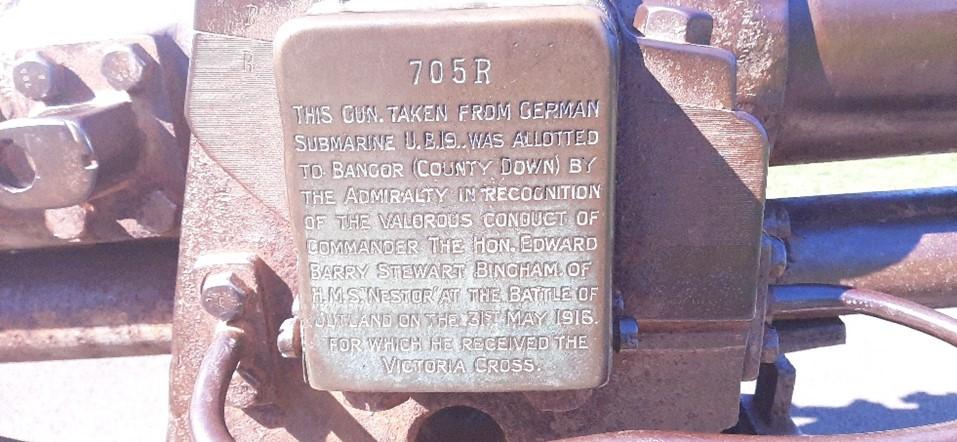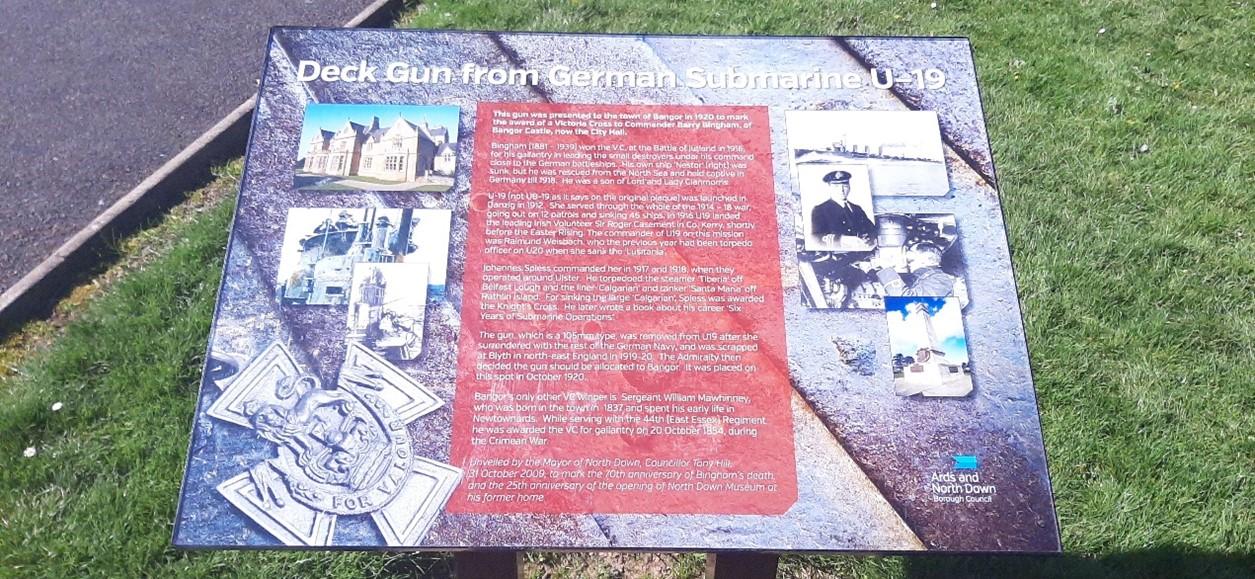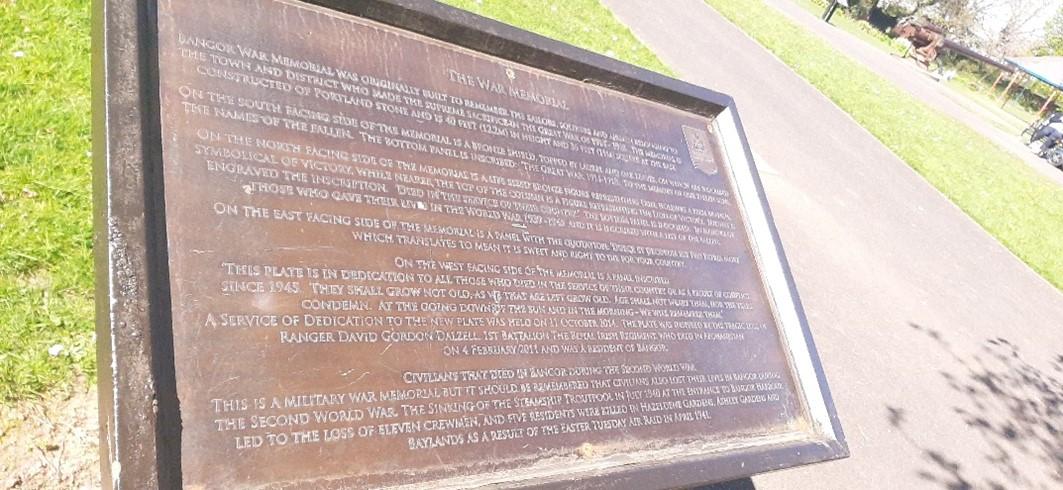
Ward Park War Memorial
The war memorial at Ward Park in Bangor commemorates the fallen from the local area in both The Great War and the Second World War.
Brass Panel on Gun Text:
705R
This gun, taken from German submarine U.B.19., was allotted to Bangor (County Down) by the Admiralty in recognition of the valorous conduct of Commander The Hon. Edward Barry Stewart Bingham of H.M.S. “Nestor” at the Battle of Jutland on the 31st May 1916 for which he received the Victoria Cross.

Interpretation Panel Text:
Deck Gun from German Submarine U-19
This gun was presented to the town of Bangor in 1920 to mark the award of a Victoria Cross to Commander Barry Bingham, of Bangor Castle, now the City Hall.
Bingham (1881-1939) won the V.C. at the Battle of Jutland in 1916 for his gallantry in leading the small destroyers under his command close to the German battleships. His own ship ‘Nestor’ was sunk, but he was rescued from the North Sea and held captive in Germany til 1918. He was the son of Lord and Lady Clanmorris.
U-19 (no UB-19 as it says on the original plaque) was launched in Danzig in 1912. She served through the whole of the 1914-18 war, going out on 12 patrols and sinking 46 ships. In 1916 U19 landed the leading Irish Volunteer Sir Roger Casement in Co. Kerry, shortly before the easter Rising. The commander of U19 on this mission was Raimund Weisbach, who the previous year had been torpedo officer on U20 when she sank the ‘Lusitania’.
Johannes Spiess commanded her in 1917 and 1918, when they operated around Ulster. He torpedoed the steamer ‘Tiberia’ off Belfast Lough and the liner ‘Calgarian’ and tanker ‘Santa Maria’ off Rathlin Island. For sinking the large ‘Calgarian’, Speiss was awarded the Knight’s Cross. He later wrote a book about his career ‘Six Years of Submarine Operations’.
The gun, which is a 105mm type, was removed from U19 after she surrendered with the rest of the German Navy, and was scrapped at Blyth in north-east England in 1919-20. The admiralty then decided the gun should be allocated to Bangor. It was placed on this spot in October 1920.
Bangor’s only other VC winner is Sergeant William Mawhinney, who was born in the town in 1837 and spent his early life in Newtownards. While serving with the 44th (East Essex) Regiment he was awarded the VC for gallantry on 20 October 1854, during the Crimean War.
Unveiled by the Mayor of North Down, Councillor Tony Hill, 31 October 2009, to mark the 70th anniversary of Bingham’s death and the 25th anniversary of the opening of North Down Museum at his former home.

Brass plaque/ Interpretation Panel Text:
THE WAR MEMORIAL
Bangor War Memorial was originally built to remember the sailors, soldiers, and airmen belonging to the town and district who made the supreme sacrifice in the Great War of 1914-1948. The memorial is constructed of Portland stone and is 40 feet (12.2m) in height and 36feet (11m) square at the base.
On the south facing side of the memorial is a bronze shield topped by laurel and oak leaves on which are inscribed the names of the fallen. The bottom panel is inscribed: ‘THE GREAT WAR 1914-1918. THE TO MEMORY OF OUR FALLEN SONS.’
On the north facing side of the memorial is a life sized bronze figure representing Erin holding a palm branch symbolic of victory. While nearer the top of the of the column is a figure representing the light of Victory. Midway is engraved the inscription ‘DIED IN THE SERVICE OF THEIR COUNTRY.’ The bottom panel is inscribed ‘IN MEMORY OF THOSE WHO GAVE THEIR LIVED IN THE WORLD WAR 1939-1945’ and it is inscribed with a list of the fallen.
On the east facing side of the memorial is a panel with the quotation ‘DULCE ET DECORUM EST PRO PATRIA MORI’ which translates to mean it is sweet and right to die for your country.
On the west facing side of the memorial is a panel inscribed ‘THIS PLATE IS IN DEDICATION TO ALL THOSE WHO DIED IN THE SERVICE OF THEIR COUNTRY OR AS A RESULT OF CONFLICT SINCE 1945. THEY SHALL GROW NOT OLD, AS WE THAT ARE LEFT GROWN OLD. AGE SHALL NOT WEARY THEM, NOR THE YEARS CONDEMN. AT THE GOING DOWN OF THE SUN AND IN THE MORNING – WE WILL REMEMBER THEM.’
A service of dedication to the new plate was held on 11 October 2014. The plate was inspired by the tragic loss of Ranger David Gordon Dalzell, 1st Battalion of the Royal Irish Regiment, who died in Afghanistan on 4 February 2011 and was a resident of Bangor.
CIVILIANS THAT DIED IN BANGOR DURING THE SECOND WORLD WAR
This is a military war memorial but it should be remembered that civilians also lost their lives in Bangor during the Second World War. The sinking of the Steamship Troutpool in July 1940 at the entrance to Bangor led to the loss of eleven crewmen, and five residents were killed in Hazeldene Gardens, Ashley Gardens and Baylands as a result of the Easter Tuesday air raid in April 1941

You might also like
Between Worlds
-
Observational Acrylic / Oil Painting
-
Outreach Class: Watercolour with Bernice Anderson
-
Beginners / Refreshers Ceramics
-
